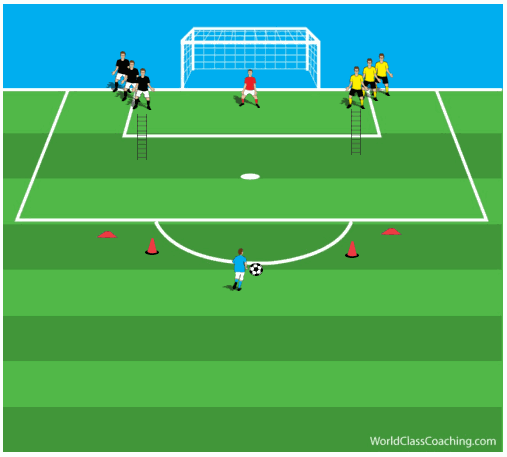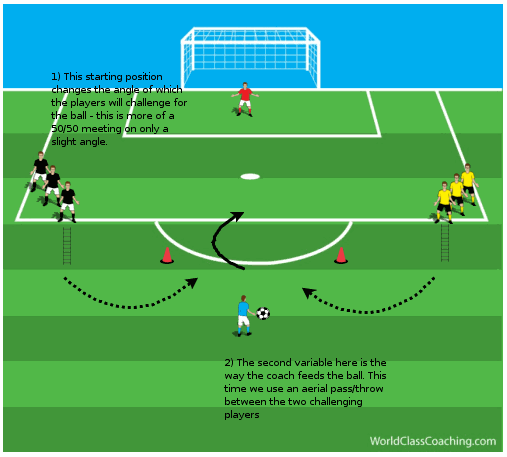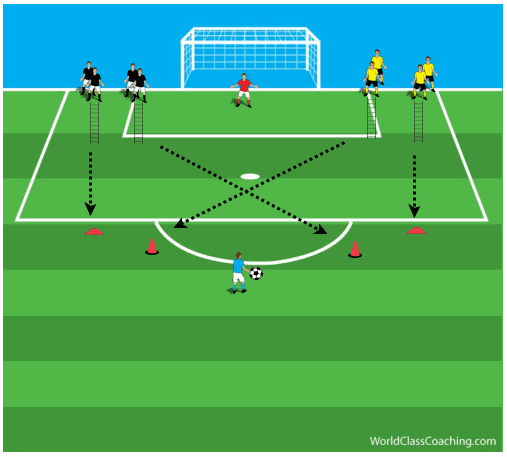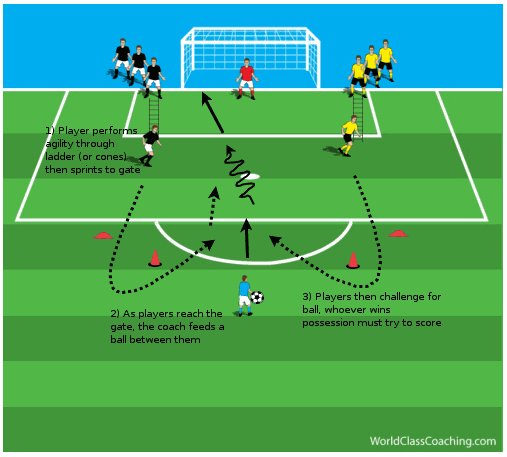Agility, Speed, 1v1 Battles and Composed Finishing by Daniel Severn
For this week’s article I’d like to share an exercise that helps to create competition in practice whilst focusing on some key aspects of the game; agility, speed, strength and finishing – all under match-like pressure. This is a great exercise that can be adjusted to suit all age groups and abilities.
To start the exercise I will offer a reward for the winning team. I have found differing rewards will help motivate different age groups/genders. A simple reward that works with ‘most’ ages can be taking a 1-0 lead into the scrimmage.
I like to offer rewards for winning team games as extra motivation for the players. Finding the right motivation can really help to push the players that extra step with their work rate, and therefore, their conditioning.
Using team challenges in sessions helps to create real competition between the players (something which is difficult to replicate from match day). Having competition between team mates will guarantee to get all players working 100%. This particular exercise will have the whole team cheering; motivating each other and working at flat out speeds. The agility and short sprints adds a great dimension, the players are so focused on the battle to get to the ball first that they don’t think about the work they have to do to get there!
Set Up and Directions:
You will need to make two teams and designate one Goalkeeper. Both teams will work towards the same goal.
Line up the teams on either side of the goal. Set up two gates (each 2 cones approx 3 yards apart) just outside the penalty box, directly in front of where the teams start. Place an agility ladder (or cones) in front of the first player in each line.
The coach positions themselves directly between the two gates with a set of soccer balls.

On the coaches’ call (or whistle) the front player from each line will use quick feet to maneuver through the agility ladder and sprint to the gate. As the player approaches the gate, the coach plays a short pass directly between the two players.
At this point, the two players will compete for possession and the winner of the battle will try to score. The player who didn’t originally win possession will still apply pressure to try and steal the ball back and score himself – this way you will keep the situation match-realistic for the striker who will be shooting with close pressure from a defender.
Play continues until the ball goes out of play, or the GK has possession.
To increase the intensity you can run a ‘quick-fire round’ which means as soon as the ball is played in for the first 1v1, the next pair sprint out to begin their 1v1. Adding a time limit onto each play helps here to keep the rotation smooth – 5-7seconds is usually suitable to cover the short distance and quick shot.
Ensure to encourage quick feet through the agility ladder and a full sprint through to the gate, remind the players that the ball is released as soon as the first player gets to the gate – therefore the harder they push themselves to win the initial race, the better chance they will give themselves of winning possession and scoring for their team.
Using two teams in this situation and keeping track of the score, or offering rewards for the winners, helps to add pressure to scoring, much like the players will find in the real game situation. This helps with composure in front of goal on game day as you have put the players in that situation many times by running this exercise.
There are many variables with this exercise:
- The starting position of the players (stood up, facing backwards, crouching, lying down etc)
- Area of the field (Start by the goal, start on the corner of the box, start from the half way line)
- Type of ball played to players (soft pass to the middle, favor one side, aerial pass/throw)

Again, this exercise can be adjusted for different levels and ages. You can also easily adjust the numbers of this game. I have often played 1v1 and then progressed to a 2v2 and 3v3 in this situation.
When adding more players to the equation, the variables continue: start position and the way the players run to the gate (e.g. one straight, one diagonal) are good things to adjust.

Challenges are the key to creating competition. With competition comes a natural work rate and desire to win. That work rate and desire to win can only result in improved conditioning with this kind of set up.
Enjoy,
Dan Severn, Program and Events Manager - BRASA Brazilian Soccer Academy



